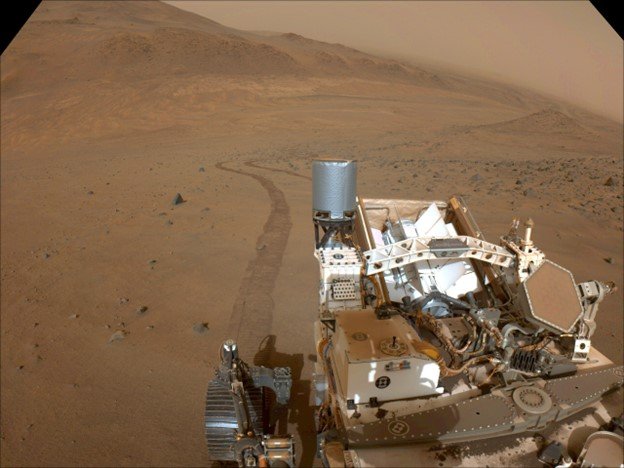Research Activities
Research in the Farley lab encompasses a wide array of geological and methodological problems. Over the past twenty years, we have developed techniques for understanding the low temperature cooling histories of rock masses. The (U-Th)/He method and 4He/3He thermochronometry allow us to explore thermal histories that illuminate paleotectonics, geomorphology, hydrocarbon maturation, and other processes. More recently, we have also begun to explore techniques such as (U-Th)/Ne dating, cosmogenic 3He and 21Ne dating, heavy noble gas geochronology, and extraterrestrial (in-situ) geochronology and surface exposure dating. Several members of the group are involved in the Mars Science Laboratory mission.
Some of these topics are described in more detail below.
(U-Th)/He Dating
The decay of 238U, 235U, 232Th, and 147Sm is accommodated through alpha-decays that produce 4He in geologic materials. Exploiting this parent-daughter system to measure time in rocks has roots that stretch back to Rutherford and the foundations of our understanding of nuclear decay, however, it is only recently that (U-Th)/He system has become widespread. The reason for the lag is that the accumulation of 4He within uranium and thorium bearing minerals is temperature dependent, meaning that at elevated temperatures characteristic of the crust, helium diffuses from mineral grains as rapidly as it is produced through alpha-decay. As rocks cool, the rate of helium diffusion drops exponentially. As a result, (U-Th)/He ages record the time since cooling, rather than the time since mineral growth. Uranium and thorium are present in trace amounts (ppm) in a number of different accessory mineral phases. Owning to differences in composition and crystallographic structure, the kinetics that govern helium diffusion vary between different minerals. The (U-Th)/He system is unique because it is sensitive to very low temperatures that, in the case of the mineral apatite (calcium phosphate), correspond several km's depth within the crust.
He Thermochronology
TBD
Neon Geochemistry and Chronology
Neon, the second-lightest noble gas, has three stable isotopes and no long-lived radioactive isotopes. The stable isotopes, 20Ne, 21Ne, and 22Ne, are present in a ratio of 9048 : 27 : 925 in the atmosphere. In other materials, neon isotopes can have different compositions compared to atmosphere, as a result of contributions from mixing components and neon production reactions. Thus, the neon system can provide a wealth of information about different processes.
Neon Components
Neon isotopes in terrestrial materials typically show a mixture of at least two components, with one of them being the atmosphere. In a neon triple isotope plot, where mixing relations are displayed as straight lines, different terrestrial materials fall in different regions, showing contributions from different extraterrestrial and/or terrestrial components, and/or neon production processes.
The ubiquitous existence of atmospheric neon in terrestrial samples has been a lingering problem in determining the neon isotope of other mixing components. Only solar wind and meteoritic components have been well-constrained due to the absence of atmospheric neon. Determining terrestrial components, such as the upper mantle and lower mantle primordial compositions, remain an unresolved puzzle.
Cosmogenic neon and nucleogenic neon also exist in some geological materials. These production reactions are determined by the exposure and thermal history of the materials, and also their chemical compositions.
Cosmogenic Neon
Cosmogenic neon comes primarily from spallation reactions caused by the interaction of cosmic radiation with elements heavier than neon. These reactions simply involve an energetic particle colliding with a heavy element and causing it to break into smaller pieces. These pieces are dominated by small particles such as protons, neutrons, and 3He, but also include larger fragments such as neon isotopes.
Cosmogenic neon accumulates in materials near the Earth's surface at a rate dependent on the cosmic radiation flux and on the properties of the material. We have been exploring the production and retention of cosmogenic neon in various phases through diffusion experiments, high altitude target experiments, and proton-irradiation experiments. With cosmogenic neon dating, we assess local erosion rates with soil samples, and determine the advance/retreat history of the glaciers with moraine samples. We also measure cosmogenic neon in young volcanic rocks to constrain their eruption age, and in rock samples collected at different elevations in the mountains to assess the local exhumation history.
Nucleogenic neon
Nucleogenic neon is produced indirectly by radioactive decay. The radium-series, thorium-series, and actinium-series decay chains of 238U, 232Th, and 235U, respectively, emit alpha particles while decaying to the stable lead isotopes 206Pb, 208Pb, and 207Pb. Most of these alpha particles come to rest as 4He. These decay chains are the basis for the well-known (U-Th)/He, (U-Th)/Pb, and U-series disequilibrium dating systems. A small proportion of the alpha particles react with other elements like oxygen and fluorine. Some of these reactions produce neon, predominantly the 18O(α,n)21Ne and 19F(α,n)22Ne reactions. The production rate and isotopic composition of nucleogenic neon depend on the composition of the material and the energies of the incident alpha particles, but they tend to be of the order of 10-8 per alpha particle. Neon produced in this way serves as a daughter product in the (U-Th)/Ne dating system. Production rates of 21Ne and 22Ne are currently calculated using calculated reaction cross section and mineral stopping power data that has not been verified experimentally. We have used the Dynamitron linear accelerator at the University of Albany to implant alpha particles into synthetic targets in order to verify these calculations. We have also performed neon diffusion experiments to investigate retentivity of neon in target phases. In addition, we have measured the (U-Th)/Ne ages of natural samples of known and unknown ages and thermal histories. In some phases, such as iron oxides, common lead contamination and low radiogenic lead concentrations preclude the use of the (U-Th)/Pb system, while low retentivity preclude the use of the (U-Th)/He system for dating even formation at low temperatures. Neon, however, appears to be retained in these phases, and we have used the (U-Th)/Ne system to date them successfully.
Mars 2020 Mission Science
Since its inception in 2012, Ken Farley has been Project Scientist for NASA's Mars 2020 mission and its rover, Perseverance. After 8 years of development and a 7 month cruise to Mars, Perseverance landed in ~40 km diameter Jezero crater in February of 2021.
In the last few years Perseverance has traversed and investigated a highly varied geologic landscape within Jezero, including intrusive and extrusive igneous rocks, sedimentary rocks deposited in a ~3.5 billion year old lake and river system, boulder-rich flood deposits, and extremely water-altered olivine-rich rocks. In Fall of 2024 the rover began its ascent up the Jezero crater rim, exploring completely different rocks which predate the crater's formation about 3.8 billion years ago.
A central goal of the Mars 2020 mission is identification, documentation, and collection of a set of about 30 samples that may be brought to Earth by future missions of the Mars Sample Return campaign. Analyzed in Earth-based laboratories, those samples may someday answer many of the great questions about Mars, including whether it ever hosted life.
To learn more about Perseverance and the Mars Sample Return effort, try these links:
Mars in-situ Geochronology
We are working on an exciting new method for performing K-Ar measurements by isotope dilution with a double spike on Mars. Below is a paper describing the development of the technique.
More coming soon.





